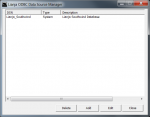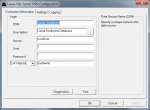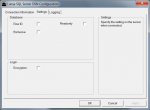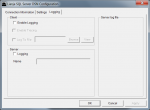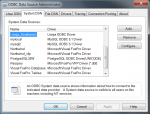Difference between revisions of "Lianja ODBC Manager on Windows"
Yvonne.milne (Talk | contribs) |
Yvonne.milne (Talk | contribs) (→Lianja DSN Configuration) |
||
| (27 intermediate revisions by 2 users not shown) | |||
| Line 1: | Line 1: | ||
==See Also== | ==See Also== | ||
| − | [[Lianja | + | [[Lianja ODBC Driver on Linux]], [[Lianja ODBC Driver on Windows]], [[Lianja Server Manager on Linux]], [[Lianja Server Manager on Windows]], [[SQL System Tables]] |
==The Lianja ODBC Manager== | ==The Lianja ODBC Manager== | ||
| Line 10: | Line 10: | ||
If you have User Account Control enabled, please click Yes on the UAC dialog displayed when you run the Lianja ODBC Manager. On Windows XP, please run the Lianja ODBC Manager as the Administrator. | If you have User Account Control enabled, please click Yes on the UAC dialog displayed when you run the Lianja ODBC Manager. On Windows XP, please run the Lianja ODBC Manager as the Administrator. | ||
<br clear=all> | <br clear=all> | ||
| + | |||
| + | <div style="height:70px;margin-top:15px;padding:5px;border:0px solid orange;border-left:5px solid orange;background:#fff8dc;vertical-align:middle;position:relative;"> | ||
| + | [[File:bm-noteicon.png|top|40px|link=]]<div style="position:absolute;top:7px;bottom:5px;margin-left:50px;"> | ||
| + | The Lianja ODBC Manager is used for Lianja ODBC Driver data sources only. If you want to create or manage data sources for other ODBC Drivers for use from Lianja, do this in the [[#Windows_ODBC_Administrator|32 bit Windows ODBC Adminstrator]]. | ||
| + | </div> | ||
| + | </div> | ||
==Lianja ODBC Data Source Manager== | ==Lianja ODBC Data Source Manager== | ||
| Line 21: | Line 27: | ||
The buttons give you access to the following operations: | The buttons give you access to the following operations: | ||
| + | <br clear=all> | ||
| − | {| class="wikitable" width=100% | + | {| class="wikitable" width="100%" |
!Operation||Description | !Operation||Description | ||
|- | |- | ||
| − | |valign=top|Delete||Delete the currently selected DSN. | + | |valign="top"|Delete||Delete the currently selected DSN. |
|- | |- | ||
| − | |valign=top|Add||Configure a new DSN. | + | |valign="top"|Add||Configure a new DSN. |
|- | |- | ||
| − | |valign=top|Edit||Configure the currently selected DSN. | + | |valign="top"|Edit||Configure the currently selected DSN. |
|- | |- | ||
| − | |valign=top|Close||Close the Lianja ODBC Manager. | + | |valign="top"|Close||Close the Lianja ODBC Manager. |
|- | |- | ||
|} | |} | ||
| Line 38: | Line 45: | ||
==Lianja DSN Configuration== | ==Lianja DSN Configuration== | ||
| + | The '''Connection Information''' tab contains all the standard configuration details. The optional '''Settings''' and '''Logging''' tabs are for optional settings. | ||
| + | |||
| + | ===Connection Information=== | ||
| + | [[{{ns:file}}:ConnectionInformation.png|150px|thumb|left|Connection Information tab]] | ||
| + | Note: The Lianja SQL Server product distribution, which includes the Lianja ODBC Driver, comes with a fully-configured DSN to the southwind sample database on the local machine. | ||
| + | |||
The following settings can be configured: | The following settings can be configured: | ||
| + | <br clear=all> | ||
| − | {| class="wikitable" width=100% | + | {| class="wikitable" width="100%" |
| − | ! | + | !Setting||Description |
|- | |- | ||
| − | |valign=top| | + | |valign="top"|DSN||Unique data source name. |
|- | |- | ||
| − | + | |valign="top"|Description||Description of data source. | |
|- | |- | ||
| − | + | |valign="top"|Server||Host name or IP address of Lianja SQL Server. | |
|- | |- | ||
| − | |valign=top| | + | |valign="top"|User||User name of valid account on the server. For the local server, this can be '?'. From v5.0 this must be a [[Users and Roles|valid Lianja user]]. |
|- | |- | ||
| − | + | |valign="top"|Password||Password for the above account on the server. For the local server, this can be '?'. From v5.0 this must be the password for the [[Users and Roles|Lianja user]] above. | |
|- | |- | ||
| − | + | |valign="top"|DATABASE or DIRECTORY||DATABASE: The name of the database on the server. DIRECTORY: The directory path where free tables are stored. | |
| − | + | ||
| − | + | ||
| − | + | ||
| − | + | ||
| − | + | ||
| − | + | ||
| − | + | ||
| − | + | ||
| − | + | ||
| − | + | ||
| − | + | ||
| − | + | ||
| − | + | ||
| − | + | ||
| − | + | ||
| − | + | ||
| − | + | ||
| − | + | ||
|- | |- | ||
|} | |} | ||
| − | [[ | + | <div style="height:70px;margin-top:15px;padding:5px;border:0px solid orange;border-left:5px solid orange;background:#fff8dc;vertical-align:middle;position:relative;"> |
| − | + | [[File:bm-noteicon.png|top|40px|link=]]<div style="position:absolute;top:7px;bottom:5px;margin-left:50px;"> | |
| − | + | From Lianja v5.0 Lianja [[Users and Roles]] are used to authenticate ODBC clients on the Lianja Server.<br>This means that [[Users_and_Roles#Row_level_Security_.28RLS.29|Row level Security]] and [[Users_and_Roles#Dynamic_Data_Masks|Dynamic Data Masks]] are also applied to Lianja data accessed via ODBC. | |
| − | + | </div> | |
| − | + | </div> | |
| − | + | ||
| − | + | ||
| − | + | ||
| − | + | ||
| − | + | ||
| + | [[{{ns:file}}:ConnectDiagnostics.png|150px|thumb|left|Connection Diagnostics]] | ||
| + | To test the connection, click '''Apply''' to apply your settings, then click '''Diagnostics...''' to open the Lianja ODBC Diagnostics window and click '''Test''' in the Configuration dialog to run the test. | ||
<br clear=all> | <br clear=all> | ||
| − | |||
| − | |||
| − | |||
| − | |||
| − | + | ===Settings=== | |
| + | [[{{ns:file}}:DSNSettings.png|150px|thumb|left|Settings tab]] | ||
| + | Additional optional settings can be configured here: | ||
<br clear=all> | <br clear=all> | ||
| − | {| class="wikitable" width=100% | + | {| class="wikitable" width="100%" |
| − | !Section|| | + | !Section||Setting||Description |
|- | |- | ||
| − | |valign=top| | + | |valign="top"|Database||Row ID||Include the rowid (number identifying the row’s physical stored position in the table) in results. |
|- | |- | ||
| − | |||valign=top| | + | |||valign="top"|Readonly||Open tables in noupdate mode. |
|- | |- | ||
| − | |||valign=top| | + | |||valign="top"|Exclusive||Open tables in exclusive mode. |
|- | |- | ||
| − | |valign=top| | + | |valign="top"|Login||Encryption||Open tables with DES3 encryption key specification required. |
|- | |- | ||
| − | ||| | + | |} |
| + | |||
| + | ===Logging=== | ||
| + | [[{{ns:file}}:Logging.png|150px|thumb|left|Logging tab]] | ||
| + | Client and server logging and ODBC tracing can be enabled and configured here. | ||
| + | <br clear=all> | ||
| + | |||
| + | {| class="wikitable" width="100%" | ||
| + | !Section||Setting||Description | ||
|- | |- | ||
| − | + | |valign="top"|Client||Enable Logging||Check to enable client-side logging. | |
|- | |- | ||
| − | |||valign=top| | + | |||valign="top"|Enable Tracing||Check to enable client-side tracing. |
|- | |- | ||
| − | |||valign=top| | + | |||valign="top"|Log To File||Name of log file. The Browse button allows the file to be selected, the View button the file to be viewed. |
|- | |- | ||
| − | |||valign=top| | + | |valign="top"|Server||Logging||Check to enable server-side logging. |
| + | |- | ||
| + | |||valign="top"|Name||Name of server-side log file. | ||
|- | |- | ||
|} | |} | ||
| − | |||
| − | |||
| − | |||
| − | |||
| − | |||
| − | |||
| − | |||
| − | |||
| − | |||
| − | |||
| − | |||
| − | |||
| − | |||
| − | |||
| − | |||
| − | |||
| − | |||
| − | |||
| − | |||
| − | |||
| − | |||
| − | |||
| − | |||
| − | |||
| − | |||
| − | |||
| − | |||
| − | |||
| − | |||
| − | |||
| − | |||
| − | |||
| − | |||
| − | |||
| − | |||
| − | |||
| − | |||
| − | |||
| − | |||
| − | |||
| − | |||
| − | |||
| − | |||
| − | |||
| − | |||
| − | |||
| − | |||
| − | |||
| − | |||
| − | |||
| − | |||
| − | |||
| − | |||
| − | |||
| − | |||
| − | |||
| − | |||
| − | |||
| − | |||
| − | |||
| − | |||
| − | |||
| − | |||
| − | |||
| − | |||
| − | |||
| − | |||
| − | |||
| − | |||
| − | |||
| − | |||
| − | |||
| − | |||
| − | |||
| − | |||
| − | |||
| − | |||
| − | |||
| − | |||
| − | |||
| − | |||
| − | |||
| − | |||
| − | |||
| − | |||
| − | |||
| − | |||
| − | |||
| − | |||
| − | |||
| − | |||
| − | |||
| − | |||
| − | |||
| − | |||
| − | |||
| − | |||
| − | |||
| − | |||
| − | |||
| − | |||
| − | |||
| − | |||
| − | |||
| − | |||
| − | |||
| − | |||
| − | |||
| − | |||
| − | |||
| − | |||
| − | |||
| − | |||
| − | |||
| − | |||
| − | |||
| − | |||
| − | |||
| − | |||
| − | |||
| − | |||
| − | |||
| − | |||
| − | |||
| − | |||
| − | |||
| − | |||
| − | |||
| − | |||
| − | |||
| − | |||
| − | |||
| − | |||
| − | |||
| − | |||
| − | |||
| − | |||
| − | |||
| − | |||
| − | |||
| − | |||
| − | |||
| − | |||
| − | |||
| − | |||
| − | |||
| − | |||
| − | |||
| − | |||
| − | |||
==Windows ODBC Administrator== | ==Windows ODBC Administrator== | ||
| − | [[{{ns:file}}: | + | [[{{ns:file}}:ODBCAdministrator.png|150px|thumb|left|ODBC Administrator]] |
Lianja ODBC data sources can also be managed using the Windows ODBC Administrator. Please note that on 64 bit systems, the 32 bit ODBC Administrator should be used (%windir%\SysWOW64\odbcad32.exe). | Lianja ODBC data sources can also be managed using the Windows ODBC Administrator. Please note that on 64 bit systems, the 32 bit ODBC Administrator should be used (%windir%\SysWOW64\odbcad32.exe). | ||
<br clear=all> | <br clear=all> | ||
| − | [[Category: | + | [[Category:Lianja SQL Server]] |
| − | + | [[Category:Lianja Server]] | |
| − | [[Category: | + | |
Latest revision as of 05:34, 5 September 2019
Contents
See Also
Lianja ODBC Driver on Linux, Lianja ODBC Driver on Windows, Lianja Server Manager on Linux, Lianja Server Manager on Windows, SQL System Tables
The Lianja ODBC Manager
The Lianja ODBC Manager allows you to create, edit and delete Lianja ODBC data sources. It can be accessed from its desktop shortcut or from the Windows Start Menu under Lianja.
User Account Control
If you have User Account Control enabled, please click Yes on the UAC dialog displayed when you run the Lianja ODBC Manager. On Windows XP, please run the Lianja ODBC Manager as the Administrator.
The Lianja ODBC Manager is used for Lianja ODBC Driver data sources only. If you want to create or manage data sources for other ODBC Drivers for use from Lianja, do this in the 32 bit Windows ODBC Adminstrator.
Lianja ODBC Data Source Manager
The Lianja ODBC Data Source Manager displays your currently configured data sources:
- Data Source Name (DSN)
- Type (System, User, File)
- Description
The buttons give you access to the following operations:
| Operation | Description |
|---|---|
| Delete | Delete the currently selected DSN. |
| Add | Configure a new DSN. |
| Edit | Configure the currently selected DSN. |
| Close | Close the Lianja ODBC Manager. |
Choosing either of the Configure operations displays the Lianja DSN Configuration dialog.
Lianja DSN Configuration
The Connection Information tab contains all the standard configuration details. The optional Settings and Logging tabs are for optional settings.
Connection Information
Note: The Lianja SQL Server product distribution, which includes the Lianja ODBC Driver, comes with a fully-configured DSN to the southwind sample database on the local machine.
The following settings can be configured:
| Setting | Description |
|---|---|
| DSN | Unique data source name. |
| Description | Description of data source. |
| Server | Host name or IP address of Lianja SQL Server. |
| User | User name of valid account on the server. For the local server, this can be '?'. From v5.0 this must be a valid Lianja user. |
| Password | Password for the above account on the server. For the local server, this can be '?'. From v5.0 this must be the password for the Lianja user above. |
| DATABASE or DIRECTORY | DATABASE: The name of the database on the server. DIRECTORY: The directory path where free tables are stored. |
From Lianja v5.0 Lianja Users and Roles are used to authenticate ODBC clients on the Lianja Server.
This means that Row level Security and Dynamic Data Masks are also applied to Lianja data accessed via ODBC.
To test the connection, click Apply to apply your settings, then click Diagnostics... to open the Lianja ODBC Diagnostics window and click Test in the Configuration dialog to run the test.
Settings
Additional optional settings can be configured here:
| Section | Setting | Description |
|---|---|---|
| Database | Row ID | Include the rowid (number identifying the row’s physical stored position in the table) in results. |
| Readonly | Open tables in noupdate mode. | |
| Exclusive | Open tables in exclusive mode. | |
| Login | Encryption | Open tables with DES3 encryption key specification required. |
Logging
Client and server logging and ODBC tracing can be enabled and configured here.
| Section | Setting | Description |
|---|---|---|
| Client | Enable Logging | Check to enable client-side logging. |
| Enable Tracing | Check to enable client-side tracing. | |
| Log To File | Name of log file. The Browse button allows the file to be selected, the View button the file to be viewed. | |
| Server | Logging | Check to enable server-side logging. |
| Name | Name of server-side log file. |
Windows ODBC Administrator
Lianja ODBC data sources can also be managed using the Windows ODBC Administrator. Please note that on 64 bit systems, the 32 bit ODBC Administrator should be used (%windir%\SysWOW64\odbcad32.exe).

